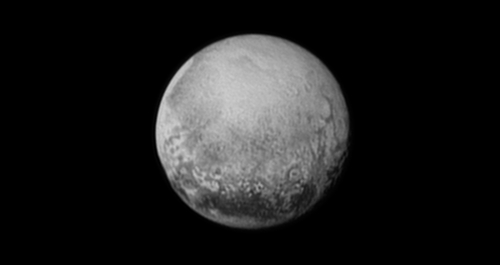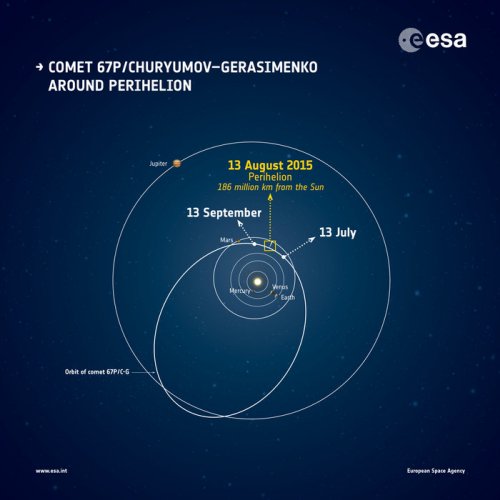We’re under the 24 hour mark for the Pluto flyby. NASA will offer a news briefing for New Horizons (check NASA TV), covering mission status and what to expect during flyby, at 1030 EDT (1430 UTC) today, a schedule change that moves the time up by half an hour. On Tuesday morning, the agency will present a live program called Arrival at Pluto Countdown starting at 0730 (1130 UTC). Remember that closest approach to Pluto is scheduled to occur at approximately 0749 (1149 UTC) on Tuesday, when the spacecraft comes within 12,500 kilometers of the surface. Gathering data, the spacecraft will be out of communication for much of that day.

Image: Pluto as seen from New Horizons on July 11, 2015. Credit: NASA/JHUAPL/SWRI
You can check NASA’s television coverage and media activities here, but I’ll also send you to Emily Lakdawalla’s page at The Planetary Society, where the indefatigable reporter has gathered in one place everything known about the schedule and other sources of information. Lakdawalla also offers a list of all the planned downlinks of image data during close approach. It’s interesting to see that Pluto will appear larger than the LORRI (Long-Range Reconnaissance Imager) field of view for less than 24 hours during the close approach.

Image: On July 11, 2015, New Horizons captured a world that is growing more fascinating by the day. For the first time on Pluto, this view reveals linear features that may be cliffs, as well as a circular feature that could be an impact crater. Rotating into view is the bright heart-shaped feature that will be seen in more detail during New Horizons’ closest approach on July 14. The annotated version includes a diagram indicating Pluto’s north pole, equator, and central meridian. Credit: NASA/JHUAPL/SWRI
What we’ll all be waiting for with no little degree of tension is the downlink scheduled for the night of July 14, which will demonstrate that after its period of intense data-taking, New Horizons has survived the encounter and will be able to transmit stored data back to Earth. Assuming that all goes well, NASA has scheduled release of close-up images for the media briefing at 1500 (1900 UTC) on July 15.
Here is what happens next, as described by Emily Lakdawalla:
Following closest approach, on Wednesday and Thursday, July 15 and 16, there will be a series of “First Look” downlinks containing a sampling of key science data. Another batch of data will arrive in the “Early High Priority” downlinks over the subsequent weekend, July 17-20. Then there will be a hiatus of 8 weeks before New Horizons turns to systematically downlinking all its data. Almost all image data returned during the week around closest approach will be lossily compressed — they will show JPEG compression artifacts. Only the optical navigation images are losslessly compressed.
Data transmission takes quite a while, with the entire dataset (lossily compressed) being downlinked starting in mid-September and continuing over a ten week period. In November, the spacecraft will downlink the entire science data set compressed without loss, a process that will take a year to complete. We’ll be keeping up with New Horizons for a long time, and here’s hoping that will include a KBO encounter and an upload of the One Earth Message.
Off on a Comet
And let’s not forget Comet 67P/Churyumov-Gerasimenko, which for over a year now has been under study by the European Space Agency’s Rosetta spacecraft. We’re now one month away from perihelion for the comet, the point at which the comet is closest to the Sun in its orbit, and therefore likely to show the greatest amount of surface activity. When Rosetta reached the comet, both were 540 million kilometers from the Sun. That distance has now closed to 195 million kilometers, and will reach 186 million km by the 13th of August.

Image: The orbit of Comet 67P/Churyumov-Gerasimenko and its approximate location around perihelion, the closest the comet gets to the Sun. The positions of the planets are correct for 13 August 2015. Credit: ESA.
“Perihelion is an important milestone in any comet’s calendar, and even more so for the Rosetta mission because this will be the first time a spacecraft has been following a comet from close quarters as it moves through this phase of its journey around the Solar System,” notes Matt Taylor, ESA’s Rosetta project scientist.
“We’re looking forward to reaching perihelion, after which we’ll be continuing to monitor how the comet’s nucleus, activity and plasma environment changes in the year after, as part of our long-term studies.”
This ESA news release has more about Rosetta’s progress. Post-Pluto/Charon, we have a summer full of fascinating science ahead with Rosetta and, of course, Dawn’s continuing work at Ceres. But first let’s get New Horizons through that flyby.



So Rosetta is already about as close to perihelion as it gets? So there wasn’t much of a show it offered. Now that the comet cools down and deactivates, maybe they will soon land the orbiter on its frozen passive surface?
Could there be life on Pluto? Better send another mission to find out:
http://www.dailygalaxy.com/my_weblog/2014/08/pluto-and-the-other-dwarf-planets-could-have-astrobiological-potential.html
It is already decided that Rosetta will end its mission on the comet by retiring on the surface of the comet (some might call it landing) But it wont happen until end of 2016. Can’t recall will the comet reach the distance where the orbiter can’t get enough sunlight, thus ending the mission for good, or the mission could be additional extended.
Anyway – the goal is to get Philae working again & get all the data it has or will produce. Philae per se is fully operational & in good condition just the comms don’t allow stable sessions ( a 50 min)
Pluto is 2 kilometers bigger than thought:
http://www.slate.com/blogs/bad_astronomy/2015/07/13/pluto_bigger_than_we_thought.html
Very early preliminary results via The Planetary Society:
http://www.planetary.org/blogs/emily-lakdawalla/2015/07131311-pluto-first-science.html
So Pluto is bigger than Eris. Pluto is made up of more ice than thought. The atmosphere is thinner than thought. Several new closeup images are on Earth. I am assuming they will use them when the masses discover that New Horizons will not be transmitting during the actual flyby, to hold back the collective screaming from those who still do not know the probe cannot take data and transmit it back at the same time.
Space artist Don Dixon pretty much got Pluto right way back in 1979:
http://www.cosmographica.com/spaceart/pluto-predicted.html
It’s rough when you live in the instant news and gratification culture:
http://blogs.agu.org/wildwildscience/2015/07/13/this-is-why-you-have-not-seen-a-bunch-of-images-of-pluto-this-weekend/
Does anyone think from the most recent photographs that Pluto looks like it has an Ice Beard ? It sure looks like it has a beard that a man has when he’s been exposed to his face getting a whole bunch of freezing rain and sleet condensing on his face beard.
When it comes down to surviving the encounter the odds seem to be in the favor of the spacecraft since probably over the eons it’s had time to sweep its orbit out of little rocks and debris
A brief pictorial history of Pluto since its discovery in 1930:
http://cseligman.com/text/planets/pluto.htm
Hubble Views of Pluto Images constructed from images taken by Hubble over 2002-2003.
It is interesting that they may have correctly constructed the “heart” and “whale” features that we are now starting to image in detail.
It happened just now!